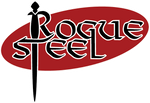Maintenance
How to care for your Rogue Steel stage combat weapons
1. Keep it Clean:
Most of our products are made from carbon steel which is prone to rust if not properly protected. We highly recommend wearing gloves when handling and using any Rogue Steel weapons that have carbon steel parts. Make sure after each use it is wiped clean of any sweat and dirt, and then apply a thin coat of light weight oil. We use Marvel Mystery Oil, but any light weight oil will do (3-in-1, gun oil, mineral oil, etc.).
We do NOT recommend using WD-40 as it evaporates too quickly and doesn’t provide adequate rust protection. Oil will not harm the leather on the grip, but it can break down the adhesive holding it on. So it's best to avoid getting too much oil on the grip if possible. If you prefer, you can use wax instead of oil. Renaissance Wax or Johnson’s Paste Wax are both good choices. Either way the goal is to create a barrier between the steel and the oxygen in the air.
2. No one likes a rusty weapon:
Keep your Rogue Steel stage combat weapons in a dry storage area. If moisture is a problem, store along with desiccant packets. If rust does form, you can use a 3M Scotchbrite pad or similar abrasive to remove it. Use the abrasive in a directional method along the longest portion where the rust exists. Using the abrasive across the area instead of along the length of it can create unwanted "scratch" lines. The idea is to maintain the polish lines while removing rust. Once the rust is gone, wipe with oil or coat with wax.
3. Burrs - The hidden danger:
ALWAYS WEAR THE PROPER SAFETY GEAR WHEN USING POWER TOOLS!
After repeated blade to blade contact, burrs (a raised edge) may start to develop on the edge of the blade or guard. These will need to be removed for continued safe use. The simplest process is to remove them with a flat file. File along the length of the edged surface with long even strokes (draw filing). The goal is to remove any sharp burrs or dings while trying to leave a slightly rounded edge. It’s a good idea to check the blade and other surfaces for burrs after each use to prevent a safety hazard. Pay particular attention during times when the weapons see a lot of use, like during rehearsals.
If you have access to power tools, a belt grinder does an excellent job of removing burrs. Go slowly so as not to remove too much metal. Again, long passes along the edge of the blade are best. Change the angle slightly to round the corners. Using small rotary tools to de-burr a blade is not recommended as it is difficult to maintain a straight edge.
4. How does this thing go together?
You shouldn’t need to disassemble a Rogue Steel stage combat weapon very often. Though, to inspect the tang or perform a thorough cleaning, our swords can be easily dis/re-assembled because of their threaded construction.
To disassemble, firmly grasp the blade or grip and unscrew the pommel. This should be capable by hand, but a vice can be used if needed (this may leave marks or scratches). Once the pommel is off, remove the grip by firmly grasping both the blade and grip to pull apart in an vertical direction. Use a rocking motion on the grip while pulling if having trouble. The guard should then easily slide off the tang of the blade. Now each individual part may be inspected or cleaned.
To reassemble, slide the guard back over the tang. The grip then slides on with the seam of the leather/rayskin in the direction of the knucklebow if equipped. The seam should lie against your fingers and not your palm. Next the pommel screws on hand tight to hold everything together. Some items like our Katanas are held in place with a recessed hex nut instead of a threaded pommel. These can be dis/re-assembled using an appropriate Allen (hex) wrench.
Most of our weapons have 6 x 1 mm metric threads. Daggers have ¼ x 20 threads, and heavier weapons (broadsword, cutlass, leaf blade) have 5/16 x 18. You can find more information about our individual blade types on our Blade Terminology page.
5. How tight is too tight?
The hilt should feel secure and not be loose or rattle. Tighten the pommel securely by hand. Tightening with a wrench or vise should be unnecessary (except for items with recessed hex nuts). Be careful not to over tighten as that will put too much stress on the tang and can eventually cause failure. Check the pommel periodically to be sure it doesn’t loosen during use.
If the hilt remains loose after properly tightening the threaded pommel or hex nut, first double check that everything was reassembled correctly. If everything is in place the way it was before disassembly and it is still loose, then there may be an issue with the weapon. Check for broken/bent pieces, dirt/debris, and any burrs on all individual parts that may be causing a problem.
6. Cleaning & Repair services:
We offer cleaning and repair services for anyone that doesn't want to tackle the issue themselves or would just feel more confident having it professionally taken care of. We can service almost all weapon types from nearly any manufacturer. If it's excessive rust, dings/burrs, bent/broken parts, replacement parts, or anywhere in between we can take care of it. We can also make changes or upgrade parts/materials if desired on most items. Visit the Repair section of our site or reach out to us anytime at info@roguesteel.com for a quote.
